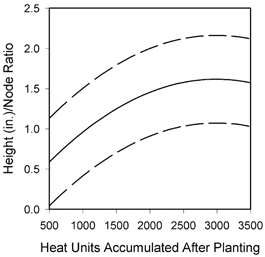Evaluation and Control of Vegetative Growth
by Jeffrey C. Silvertooth,
Extension Agronomist, Professor & Head, SWES
Ideally, transition from vegetative to fruiting branches in cotton should occur at nodes 5, 6, or 7. Some cotton fields in Arizona in the 2001 season have initiated the first fruiting branches above node 7. This can sometimes provide an early indication of enhanced vegetative growth potential for the early stages of the fruiting cycle. Managing the balance between vegetative and reproductive growth is an important aspect of crop management, particularly under irrigated conditions. In addition, reproductive potential during the early period of the fruiting cycle is crucial to gain crop earliness and yield potential. We have also found this can perhaps affect fiber properties such as micronaire. Hence, it is important to assess crop conditions in each field early in the season so that management adjustments can be made appropriately.
Applications of various plant growth regulators (PGRs) are often used as tools to help manage balance between vegetative and reproductive growth, often referred to as crop vigor. A popular PGR used in cotton production is mepiquat chloride (MC), often referred to by common trade names (i.e. PIXtm, Regulextm, etc.). A considerable amount of research has been conducted in Arizona to evaluate MC effects on cotton growth, development, and yield. Analysis of the cumulative information obtained from over 30 field experiments that were conducted in many cotton-producing areas in Arizona over the past 13 seasons provides some important information regarding PGR use in Arizona cotton. A more detailed description of these analyses is published in the 2000 University of Arizona Cotton Report, Series P-121 (p. 72-88). This article can also be found on the UA-Crops website at http://cals.arizona.edu/crops/cotton from the "Research" section.
Of the many factors that are to be considered in evaluating a cotton crop, fruit retention (FR) and plant vigor by use of a height to node ratio (HNR) are among the most useful. Baselines developed in Arizona can be used to reference FR and HNR conditions for any field based on heat unit accumulations after planting (HUAP, 86/55 oF thresholds) (Figure 1). For both the HNR and FR figures, the middle baseline describes average or well-balanced growth conditions. In the case of the HNR guidelines, values below the baseline indicating low crop vigor and a need to avoid MC applications. The best probability for a positive crop response can be realized when HNR values are above the middle baseline . Recommendations and guidelines from the University of Arizona regarding MC use (PIXtm) are summarized in several bulletins (i.e. J.C. Silvertooth and E.R. Norton. 1998. Publication No. AZ 1049, Cooperative Extension, College of Agriculture, University of Arizona).
The information in Tables 1 and 2 outlines the general response patterns that were revealed by the analyses developed in Arizona over the past 13 seasons. Conclusions that can be drawn from these results indicate that the probability of a positive yield response to MC applications is very low. However, the probability of realizing a positive yield response from MC applications can be improved by use of simple plant measurements to estimate vigor (HNR) and fruit load (FR). Accordingly, MC applications should be considered on fields that have a high HNR and avoided on fields that have low vigor relative to the established baselines for HNRs in Arizona (Figure 1). It is also important to point out that plant height and general plant architecture was significantly reduced from most MC treatments even if yield was not significantly affected.
From the results summarized in Table 2 we have found that the HNR is a simple tool that can be used effectively in evaluating crop vigor and assisting with the decisions for PGR use on cotton in Arizona. Therefore, it is important to evaluate crop vigor (HNR) at several points early in the season.


Figure 1. Height to node ratio and percent fruit retention baselines for
Arizona grown cotton varieties.
Table 1. Yield response distribution among mepiquat chloride experiments, AZ, 1987-1999.
|
Yield Response |
% of Cases |
|
Positive |
15
|
|
Negative |
17 |
|
None |
68
|
Yield response in relation to untreated check. P< 0.05, n = 148
Table 2. Yield responses and relationships to crop condition at the time of mepiquat chloride application, multiple AZ experiments, 1987-1999.
|
Positive Yield Response
|
Negative Yield Response
|
||
|
Height to Node Ratio |
Fruit Retention |
Height to Node Ratio |
Fruit Retention |
|
100 % above baselines |
61 % above baselines |
100 % below baselines |
100 % above baselines |
|
39% below baselines |
|||
Issued in furtherance of Cooperative Extension work, acts of May 8 and June 30, 1914, in cooperation with the U.S. Department of Agriculture, James A. Christenson, Director Cooperative Extension, College of Agriculture and Life Sciences, The University of Arizona.
The University of Arizona is an equal opportunity, affirmative action institution. The University does not discriminate on the basis of race, color, religion, sex, national origin, age, disability, veteran status, or sexual orientation in its programs and activities.
Any products, services, or organizations that are
mentioned, shown, or indirectly implied in this web document do not imply
endorsement by The University of Arizona.
Information provided by Jeffrey C. Silvertooth, silver@ag.arizona.edu
Extension Agronomist, Professor & Head, SWES, College of Agriculture and Life Sciences, The University of Arizona.
Material written June 15, 2001.
Crop Mgmt | Soil Mgmt | Irrigation | Varieties | Cotton Comments
Home | Cotton | Advisories
document located at: http://cals.arizona.edu/crops/cotton/comments/june2001cc.html
Copyright © 2001 University of Arizona,
College of Agriculture and Life Sciences
Webmaster: Al Fournier (acis@ag.arizona.edu)